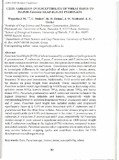Variation in susceptibility of wheat parts to major fusarium head blight pathogens

View/
Date
2011-09Author
Oerke, E. C.
Muthomi, J. W.
Dehne, H. W.
Steiner, U.
Wagacha, J. M.
Language
enMetadata
Show full item recordAbstract
Fusarium head blight (FHB) of wheat is caused by a complex of pathogens with
F graminearum, F. culmorum, F. poae, F. avenaceum and F. tricinctum being
the most common worldwide. Besides ears, the species have been isolated from
wheat roots, foot, stems, ears and leaves. Greenhouse studies were carried out
to investigate differences in susceptibility of wheat parts - leaves, stems,
kernels and spikelets - to the five Fusarium species inoculated at mid-anthesis.
Tissue susceptibility was assessed by establishing Fusarium spp. re-isolation
frequency 20 days post inoculation. Additionally, FHB severity and effect of
the disease on grain weight were assessed. Tissue susceptibility to the
Fusarium isolates varied significantly (p $; 0.05) and was in decreasing order:
spikelets (mean 83%), kernels (mean 79%), stems (mean 75%), and leaves
(mean 31%). Fusarium graminearum and F. culmorum were re-isolated in the
highest frequency from spikelets and kernels, respectively while the
corresponding lowest re-isolation frequencies were F. avenaceum and F.poae;
and F. poae. Fusarium head blight was initiated earlier and progressed
significantly faster (p s 0.05) on plants inoculated with F. culmorum and F.
graminearum than the other three isolates. Area under disease progress curve
varied significantly (p $; 0.05) and decreased in the order: F. graminearum, F.
culmorum, F. tricinctum, F. avenaceum and F.poae, respectively. All Fusarium
isolates except F. poae caused a significant reduction in 1000-kernel weight
with F. culmorum resulting in the highest (87%) reduction, compared to noninoculated
controls. Fusarium species infect vegetative wheat parts where they
may survive between cropping cycles and contribute inoculum for FHB
development in a subsequent crop.
Citation
Optimimization of Agricultural Value Chains for sustainable DevelopmentSponsorhip
National Council of Science and Technology, The Kenya Seed CompanyPublisher
Faculty of Agriculture, University of Nairobi
Description
aGRO 2011 Biennial Conference presentation
